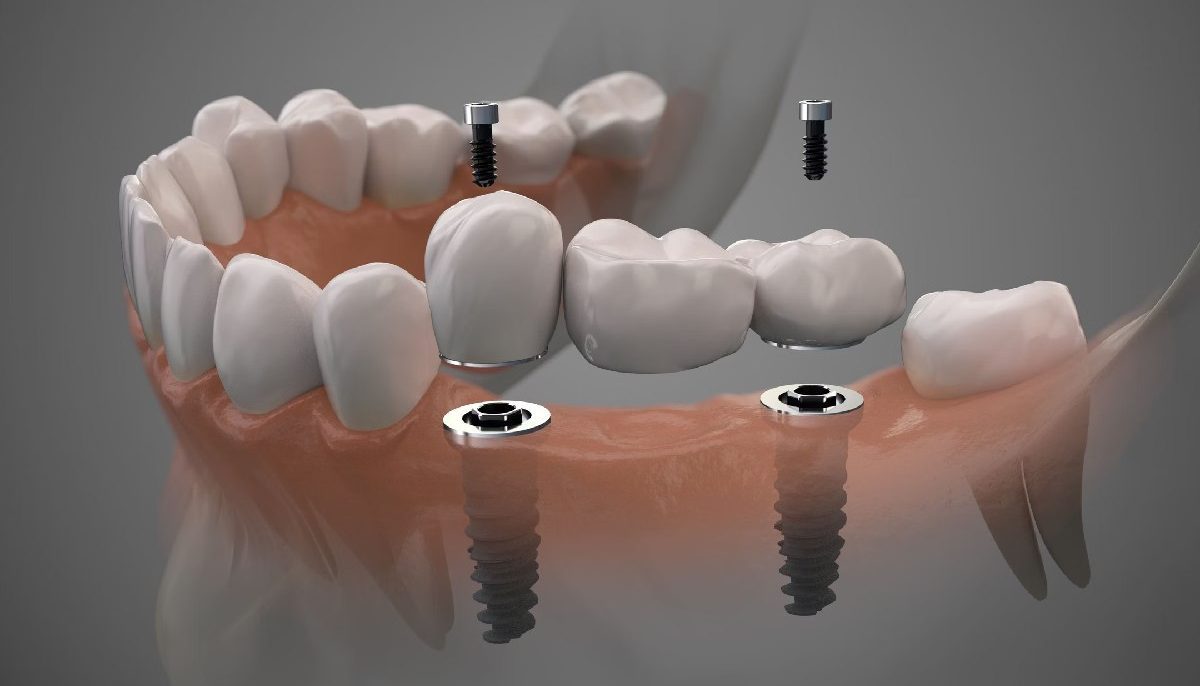Dental Implants: Guide to Restoring Your Smile and Function

A dental implant is more than just a solution to a missing tooth—it’s an investment in your health, appearance, and confidence. If you’ve been living with a gap in your smile, or you’re struggling with dentures or bridges, a dental implant might be the key to transforming not only your smile but your overall quality of life. But what exactly is a dental implant? How does it work? And what can you expect from the procedure? In this guide, we’ll dive deep into everything you need to know about dental implants, addressing common concerns, and explaining why they may be the best choice for you.
What is a Dental Implant?
A dental implant is a modern solution to replace missing teeth. Unlike traditional dentures or bridges, dental implants don’t just sit on top of the gums; they become a permanent part of your mouth. Essentially, a dental implant is a small titanium post that is surgically placed into your jawbone. Over time, the bone and implant fuse together in a process known as osseointegration, making the implant feel just like a natural tooth root.
The implant itself serves as a stable base for various types of dental restorations, such as crowns, bridges, or dentures. These restorations are custom-made to match the shape, size, and color of your natural teeth, creating a seamless look that enhances your smile.
Dental implants are known for their longevity and strength. Because the implant integrates with the bone, it provides a secure foundation, helping to restore both the function and appearance of the tooth. Whether you’ve lost a tooth due to decay, injury, or disease, dental implants can provide a permanent solution that improves your chewing ability, speech, and overall dental health.
Why Would You Need a Dental Implant?
There are numerous reasons someone might need a dental implant. Perhaps the most common reason is tooth loss, which can occur due to trauma, decay, or periodontal disease. If you’ve lost a tooth, you might have noticed the negative impact it can have on your ability to eat certain foods, speak clearly, or smile confidently.
For many people, dental implants are a superior option compared to traditional dentures or bridges. Unlike dentures, which can slip or move around, dental implants are securely anchored into the jawbone, providing a permanent solution that feels and functions like a natural tooth.
Unlike bridges, which often require the alteration of surrounding healthy teeth, dental implants only affect the area where the tooth is missing, preserving your natural tooth structure.
Furthermore, dental implants help to maintain the health of the jawbone. When a tooth is lost, the bone in that area can begin to shrink over time. Dental implants stimulate the bone, preventing bone loss and helping to preserve the structure of your face. This is something dentures and bridges can’t offer, which is why dental implants are often the most recommended solution for long-term dental health.
How Are Dental Implants Placed?
The process of getting a dental implant typically takes several months, but it’s a well-established and predictable procedure with a high success rate. Here’s a step-by-step overview of what you can expect.
-
- Initial Consultation: Before any procedure, you’ll meet with your dentist or oral surgeon to discuss your medical history and examine your mouth. X-rays or 3D scans may be taken to assess the condition of your jawbone and ensure that there is enough bone to support the implant. If there isn’t enough bone, additional procedures like bone grafting may be necessary.
- Surgical Placement of the Implant: The first step in the implant procedure is the surgical placement of the titanium post into the jawbone. This is typically done under local anesthesia, so you won’t feel any pain. In some cases, sedation may be used if you’re feeling anxious. The dentist or oral surgeon will carefully place the implant into the bone, then close the area with stitches.
- Healing and Osseointegration: After the implant is placed, it will need time to heal. During this time, the bone will fuse with the titanium post, a process known as osseointegration. This typically takes several months (usually between three to six months). Once the implant is securely integrated with the bone, it provides a solid foundation for the restoration.
- Placement of the Restoration: After the implant has fully integrated, you’ll return to the dentist to have your custom-made crown, bridge, or denture placed on top of the implant. This restoration is carefully designed to match your natural teeth in both appearance and function, allowing you to chew and speak comfortably once again.
Is Getting a Dental Implant Painful?
One of the most common concerns about dental implants is the fear of pain. However, the procedure is not as painful as many people imagine. Most patients report that the pain during the implant procedure is minimal or nonexistent, thanks to local anesthesia. Sedation options are also available for patients who feel anxious about the procedure.
After the surgery, some discomfort, swelling, or bruising around the implant site is normal. This is typically managed with over-the-counter pain relievers, and the discomfort usually subsides within a few days to a week. If you experience any unusual pain or complications, your dentist will provide specific instructions on how to care for the implant site and when to seek follow-up care.
It’s important to remember that dental implants are an investment in your long-term health and comfort. While there may be some short-term discomfort, the benefits far outweigh the temporary inconvenience.
Dental Implant Recovery: What to Expect
Recovery from dental implant surgery is relatively straightforward for most patients. However, it’s important to follow your dentist’s instructions carefully to ensure a smooth healing process. Here’s what you can expect during recovery:
- Immediate Post-Operative Care: Right after the surgery, you may be advised to rest for the remainder of the day. You’ll likely experience some swelling and discomfort, which can be managed with ice packs and over-the-counter medications. The dentist may also prescribe antibiotics to prevent infection.
- Dietary Restrictions: During the initial healing phase, you’ll need to avoid chewing on the side where the implant was placed. Soft foods are recommended, and you should avoid hot or spicy foods that could irritate the surgical site.
- Healing Time: The initial recovery period typically lasts for one to two weeks, during which time the stitches will dissolve, and the swelling will begin to subside. However, the full process of osseointegration takes a few months. During this time, it’s essential to maintain proper oral hygiene to avoid complications.
- Follow-Up Appointments: Your dentist will schedule follow-up appointments to monitor the healing progress. If everything goes as planned, the restoration will be placed once the implant has fully integrated with the bone.
Are Dental Implants Safe?
Yes, dental implants are very safe when performed by a skilled dentist or oral surgeon. In fact, the success rate for dental implants is very high—around 95%—due to advancements in surgical techniques and implant materials. However, as with any medical procedure, there are some risks involved, including infection, nerve damage, or implant failure. Choosing an experienced and reputable dentist is essential to minimizing these risks.
Your dentist will carefully evaluate your medical history, jawbone condition, and overall health to ensure you’re a good candidate for dental implants. If you have underlying health conditions, such as diabetes or gum disease, these issues will need to be managed before proceeding with the implant procedure.
Long-Term Benefits of Dental Implants
Dental implants provide numerous long-term benefits that go beyond just the restoration of a smile. First and foremost, they offer a permanent solution to missing teeth, which can significantly improve your self-esteem and confidence. You’ll no longer have to worry about gaps in your smile or the discomfort of dentures that slip or require adhesives.
Beyond aesthetics, dental implants also help maintain your oral health. When a tooth is missing, the surrounding bone can begin to shrink, which can affect the structure of your face and mouth. Dental implants stimulate the jawbone, helping to preserve its strength and volume. This means that dental implants can help prevent the bone loss that often occurs with other types of tooth replacements.
Additionally, dental implants improve your ability to chew, speak, and smile comfortably. Because they function like natural teeth, you won’t have to worry about slipping or shifting, and you’ll be able to eat a wider variety of foods with ease.
Frequently Asked Questions
A: Dental implants are designed to last a lifetime with proper care. With good oral hygiene and regular dental check-ups, your implants can provide a durable, long-term solution to missing teeth.
A: Yes, dental implants are very safe, especially when performed by a qualified and experienced professional. Modern techniques have made implants one of the most successful dental procedures.
A: The procedure is not painful because local anesthesia is used. After the surgery, you may experience some discomfort, but this is typically manageable with pain relievers.
Conclusion
Dental implants are a transformative solution for anyone suffering from missing teeth. Whether you’re looking to restore your smile, improve your oral health, or regain your confidence, dental implants offer long-lasting benefits. If you’re considering dental implants, the first step is to consult with a trusted dentist who can evaluate your needs and guide you through the process. Reach out to schedule your consultation today and take the first step toward a healthier, more beautiful smile.
